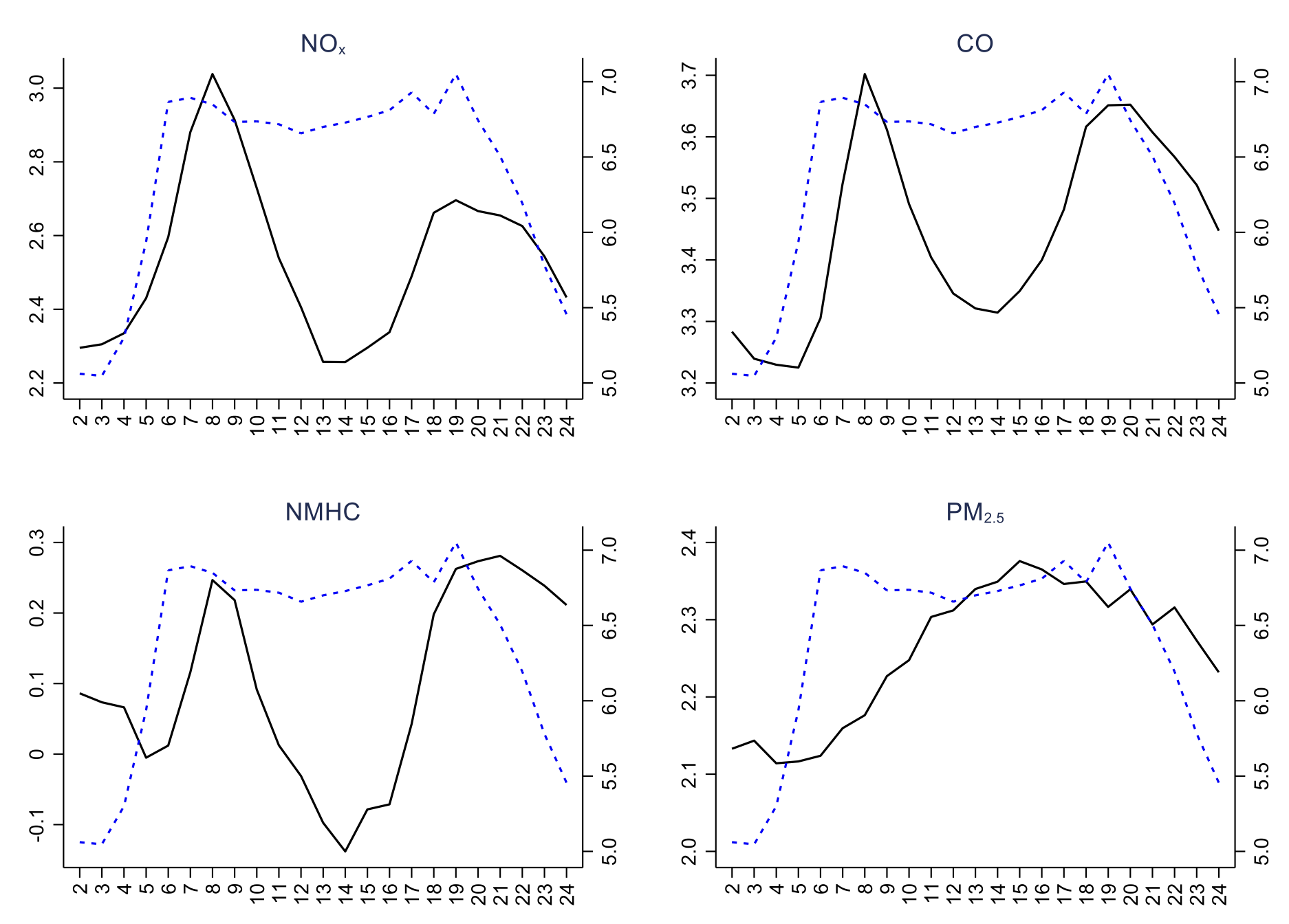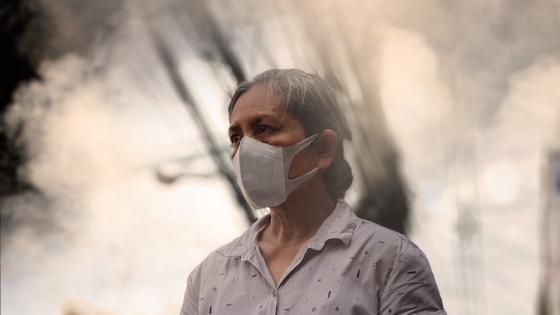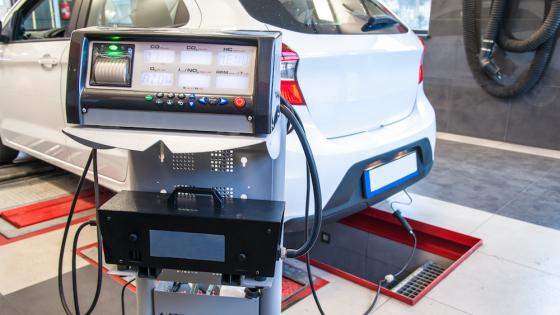For reasons including seeking to reduce the adverse health effects of vehicular air pollution, major cities around the world have introduced various policies to reduce or manage road traffic flows. London, Milan, San Diego, and Stockholm have introduced road-pricing schemes. Some cities have also employed regulatory approaches, such as the 'Hoy No Circula' driving restrictions in Mexico City, the 'Pico y Placa' driving restrictions in Quito, the odd-even/one-day-per-week programme in Beijing, and low-emission zones in European cities.
Empirical evidence has revealed that these policies are effective in reducing road traffic flows. However, the sizes of their pollution-reducing effects remain ambiguous. For example, Gibson and Carnovale (2015) analysed Milan’s ‘Area C’ road pricing policy, finding that it reduced entries of relevant vehicles into the priced area and the ambient carbon monoxide (CO) concentration in the area. However, no significant effect was observed on ambient fine particulate matter (PM2.5). Green et al. (2020) examined London’s Congestion Charge, finding that it reduced both the annual vehicle miles driven by covered vehicles and ambient concentrations of CO and PM2.5 in the priced area. However, they found that nitrogen dioxide (NO2) levels in the priced area increased as a result of the policy. These results raise the question of the size of the link between road traffic flows and air pollution.
In a recent paper (Nishitateno et al. 2023), we study the relationship between road traffic flows and local air pollution concentrations in Japan. The case of Japan is relevant for three key reasons. First, diesel vehicle driving restrictions were introduced in 2003 to improve air quality in Tokyo, with some prior work presenting evidence on their pollution-reducing effects (Rutherford and Ortolano 2008, Nishitateno and Burke 2022). However, the links between road traffic flows and air pollution concentrations have yet to be estimated. Second, high-quality granular data on road traffic flows and air pollution concentrations are available for Japan, making it a good setting to study. Third, Japan is a populous country and continues to seek to improve ambient air quality. A better understanding of the causes of ambient air pollution may provide insights for policies to improve public health.
Figure 1 displays the temporal variation in the four air pollutants designated under the vehicle emission standards of Japan and road traffic flows during the day. The blue dotted line shows the log of the average road traffic flow per hour. The black line represents the log of the average hourly ambient concentration of each air pollutant. The road traffic flow variable exhibits two peaks during the day: one at 7:00 and the other at 19:00. The hourly ambient concentrations of NOx, CO, and NMHC appear to be correlated with hourly road traffic flows. In contrast, such an association cannot be observed for PM2.5, for which hourly ambient concentrations peak at 15:00.
Figure 1 Temporal variation in road traffic flow and vehicular air pollution concentration
Notes: The graphs show the temporal variations in the natural logarithm of the average hourly road traffic flow (blue dotted line, right axis) and the natural logarithm of the average hourly ambient concentrations of the four vehicular air pollutants (black line, left axis). NOx, nitrogen oxide; CO, carbon monoxide; NMHC, non-methane hydrocarbons; PM2.5, fine particulate matter. The first hour of the day is omitted.
There are many factors to consider when estimating links between pollution concentration and road traffic flows. First, meteorological conditions are relevant, in particular because the air pollutants we are studying are not uniformly mixed (Perman et al. 2011). Second, pollution concentrations for pollutants that are not pure flow pollutants are functions of both current and previous emissions (Perman et al, 2011), making it important to consider dynamics. For instance, a vehicle passing a location in the final minute of an hour is likely to mostly affect the average pollution concentration in the next hour rather than the same hour.
Controlling for meteorological conditions and other relevant factors, we estimated a dynamic panel model to obtain short- and long-run elasticities of pollution concentrations to road traffic flows for the four pollutants shown in Figure 1 and also NO2. Table 1 reports the results, showing short-run elasticities of pollution concentrations to motor vehicle flows of 0.03–0.05 for NOx, CO, NMHC, and NO2. Assuming that the dynamic relations observed over a 24-hour period can be extrapolated, long-run elasticities for these pollutants are in the range of 0.09 to 0.17. No significant evidence of pollution concentration-road traffic flow links is found for PM2.5.
Table 1 Pollution concentration-road traffic flow elasticity
Note: ***, **, and * indicate statistical significance at 1%, 5%, and 10%, respectively.
In 2021, the World Health Organization (WHO) introduced new air-quality guidelines (WHO 2021). The limits in terms of the 99th percentile values of 24-hour averages in a given year were set at 25 μg/m3 for NO2, 4 mg/m3 for CO, and 15 μg/m3 for PM2.5. As of 2019, based on our dataset approximately 86% of Japan’s air monitoring stations were noncompliant with the standard for NO2, 17% with the standard for CO, and 100% with the standard for PM2.5.
On its own, would a reduction in road traffic flows be highly useful in achieving the new WHO air quality targets? The small elasticities of pollution concentration to road traffic flows that we have found mean this is unlikely. For example, utilising the estimated long-run pollution concentration-road traffic flow elasticity for NO2 (0.09), we calculated the changes in the number of days with levels exceeding the new standard for each pollution monitoring station if road traffic flows around each pollution monitoring station decreased by half. It was found that only 20 out of 1,420 pollution monitoring stations would become compliant across the country based on this change.
The key implication is that more specific road sector pollution reduction policies are required rather than targeting road traffic flow numbers alone. The adoption of clean vehicles, including battery electric vehicles (BEVs) and fuel cell vehicles (FCVs), is a promising way forward. Another alternative is to use diesel vehicle registration restrictions and low-emission zones. Diesel vehicle restrictions have already been adopted by some prefectures to reduce ambient concentrations of NOx and PM2.5 by keeping highly polluting diesel trucks and buses away from designated areas. Nishitateno and Burke (2020, 2021) present evidence that these interventions have been effective in improving local air quality.
Efforts beyond road transport are also necessary. An important reason for the inelasticity in effect sizes obtained in this study is that the road sector is only one contributor to pollution. Indeed, as of 2019, road transport accounted for only approximately 21% of total anthropogenic NOx emissions in Japan (1.2 million tonnes), whereas the contributions from other mobile sources, power stations, and industrial combustion were 25%, 15%, and 32%, respectively (OECD 2023). There is substantial scope for energy efficiency improvements, electrification, and switching to low-emission fuels across non-road sector activities.
Editor’s note: The main research on which this column is based (Nishitateno et al 2023) first appeared as a Discussion Paper of the Research Institute of Economy, Trade and Industry (RIETI) of Japan.
References
Gibson, M and M Carnovale (2015), “The effects of road pricing on driver behavior and air pollution”, Journal of Urban Economics 89: 62-73.
Green, C P, J S Heywood and M N Navarro Paniagua (2020), “Did the London congestion charge reduce pollution?”, Regional Science & Urban Economics 84, 103573.
Nishitateno, S and P J Burke (2020), “Have vehicle registration restrictions improved urban air quality in Japan?”, Contemporary Economic Policy 38(3): 448-459.
Nishitateno, S and P J Burke (2021), “Willingness to pay for clean air: evidence from diesel vehicle registration restrictions in Japan”, Regional Science & Urban Economics 88, 103657.
Nishitateno, S and P J Burke (2022), “Effects of low emission zones on air quality, new vehicle registrations, and birthweights: Evidence from Japan”, RIETI Discussion Paper 22-E-109.
Nishitateno, S, P J Burke and T H Arimura (2023), “Road Traffic Flow and Air Pollution Concentrations: Evidence from Japan”, RIETI Discussion Paper 23-E-031.
Perman, R, Y Ma, M Common, D Maddison and J McGilvray (2011), Natural resource and Environmental Economics, 4th edition, Pearson Education.
Rutherford, D and L Ortolano (2008), “Air quality impacts of Tokyo’s on-road diesel emission regulations”, Transportation Research Part D: Transport and Environment 12: 239-254.
WHO – World Health Organization (2021), “WHO Global Air Quality Guidelines: Particulate Matters (PM2.5 and PM10), Ozone, Nitrogen Dioxide, Sulfur Dioxide and Carbon Monoxide”.








